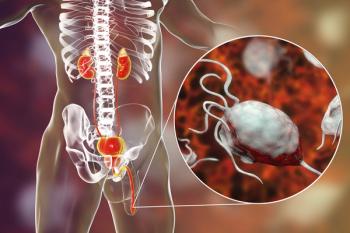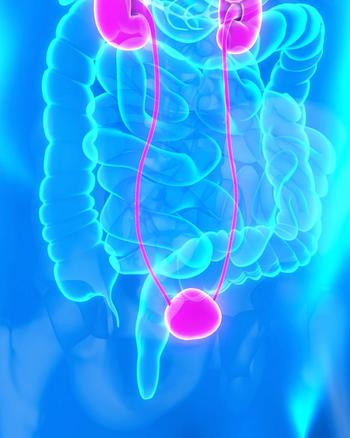
Oncology NEWS International
- Oncology NEWS International Vol 6 No 1
- Volume 6
- Issue 1
Good Outcomes Seen With Hyperfractionated Conformal RT
LOS ANGELES--By using hyper-fractionation, radiation oncologists at Wayne State University were able to deliver an isocenter dose of 85 Gy to the prostate in men with locally advanced prostate cancer, producing a 95% negative biopsy rate.
LOS ANGELES--By using hyper-fractionation, radiation oncologists atWayne State University were able to deliver an isocenter dose of 85 Gyto the prostate in men with locally advanced prostate cancer, producinga 95% negative biopsy rate.
"Instead of giving a standard fraction of 1.8 to 2.0 Gy once aday up to a standard total dose of about 70 Gy, we gave 1.15 Gy twice aday," said Jeffrey D. Forman, MD, in an interview about his posterpresentation at the American Society for Therapeutic Radiology and Oncology(ASTRO) (see illustration).
Using conformal radiation and 3D treatment planning in prostate cancerpatients, researchers have been able to reduce the amount of radiationto the surrounding normal tissue, but were still encountering significantcomplications at high doses. "Careful and precise aiming by itselfwas not sufficient to prevent complications to the rectum and bladder,"Dr. Forman said, "so we turned to hyperfractionation, ie, the deliveryof multiple, smaller than normal fractions of radiation each day."
No Severe Complications
Hyperfractionation is effective at treating cancer while sparing normaltissue, he said, because the effect of treatment on the cancer is dictatedby the maximum total radiation dose, while the effect on normal cells dependsmore on the size of each individual dose.
In Dr. Forman's dose-escalation study using hyperfractionated conformalradiotherapy, there were no severe complications at the first dose levelof 80 Gy, and about half the patients had negative findings on post-radiationbiopsies, "an improvement over the 25% negative biopsy rate generallyseen with standard doses," he said.
These patients were monitored for about a year before the researchersmoved to the next dose level of 85 Gy. Again, there were no severe complicationsamong the 24 patients receiving this dose level, and the negative biopsyrate rose to 95%.
This created a dilemma, Dr. Forman pointed out. Although the low toxicityjustified continuing the study to the next dose level of 90 Gy, "because95% of patients had no cancer in their biopsy specimen, we felt that ethically,it didn't make sense to continue to the next dose level, since it wouldbe hard to improve on those results."
The researchers elected to close the study early and continue to monitorthe patients who received the 85 Gy dose to make sure that local controlrates are maintained. "If they are not maintained, then we will goto the next dose level; if they are, then we're done," Dr. Formansaid, adding that the next goal would be to confirm the results in a largerclinical trial. Currently, he said, the patients have been followed for2 to 4½ years.
In this protocol, the fractions were given at 6- to 8-hour intervals,so patients could come in at 7 or 8 AM for their first treatment and returnabout 4 PM for their second dose, he said, allowing patients who were workingto work a full day between treatments. The treatment, which continued for7½ weeks, was well tolerated, with patients able to maintain theirnormal daily activities.
Somewhat confounding the results was the fact that many patients alsoreceived preradiation hormonal therapy. "Between the time in early1992 when we opened the study and treated patients at the first dose leveland the time we started the second dose level, data on RTOG 8610 becameavailable showing that in this population of patients, preradiation hormonaltherapy is beneficial, so we elected to include that in the treatment regimen,"he said. All but four patients at the second dose level received pretreatmenthormones.
Dr. Forman acknowledged that the hormonal treatment contributed to theexcellent results seen at the 85 Gy dose level. "Some people criticizedthe study, saying that by adding hormonal therapy, we were losing the abilityto know how much was really gained from the increased dose, but from myperspective, the goal of the treatment is to get rid of the cancer withoutserious side effects, and if it takes two types of treatment to do that,I'm not really concerned with knowing the precise contribution of eachtreatment."
Dr. Forman's colleagues in the study were Arthur T. Porter, MD, PaulKocheril, MD, David Grignon, MD, and Colin Orton, PhD.
Articles in this issue
almost 29 years ago
New Board to Deal With Cancer Policy Issuesalmost 29 years ago
MoAb Shows Positive Results in Lymphoma Patientsalmost 29 years ago
Prostate Cancer Gene Location Narrowed to Chromosome 1 Armalmost 29 years ago
New BCG Bladder Cancer Indication Gets Panel Nodalmost 29 years ago
Panel Advises FDA To OK Letrozole for Advanced Breast Canceralmost 29 years ago
Limited Diagnostic Testing After Breast Cancer Treatment Urgedalmost 29 years ago
Pressures of Managed Care Spur Interest in Clinical Guidelinesalmost 29 years ago
Baltimore Will Head New Effort To Develop a Vaccine for HIValmost 29 years ago
Epidemiologist Challenges Tamoxifen, Second Cancer Linkalmost 29 years ago
Cancer Care's AIDS Pain Booklet AvailableNewsletter
Stay up to date on recent advances in the multidisciplinary approach to cancer.


















































































